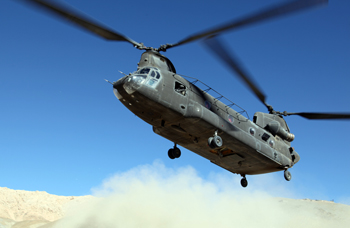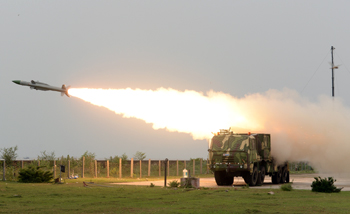INDIAN ARMED FORCES CHIEFS ON
OUR RELENTLESS AND FOCUSED PUBLISHING EFFORTS

SP Guide Publications puts forth a well compiled articulation of issues, pursuits and accomplishments of the Indian Army, over the years

I am confident that SP Guide Publications would continue to inform, inspire and influence.

My compliments to SP Guide Publications for informative and credible reportage on contemporary aerospace issues over the past six decades.
- Interim Defence Budget 2024-25 — An Analysis
- Union Defence budget 2024
- Indian Army: In quest of greater firepower and policy recommendations for gaps
- Indian Army Annual Press Conference 2024
- 6G will transform military-industrial applications
- Tata Boeing Aerospace Delivers 250 AH-64 Apache Fuselages, Manufactured in India
One year of Defence under Modi Government
It is envisaged that under a new procurement policy, at least half of India's total weapon and equipment needs in the next 10 to 12 years (worth more than $100 billion) could be produced domestically.
 |
By Lt. General P.C. Katoch (Retd) Former Director General of Information Systems, Indian Army |

The media is agog with TV debates, editorials and articles about the one year of the present government. However, as far as defence of the country is concerned, it is individual news items like 'Make in India', weapon system imports like Rafale, success of Dhanush (product of ToT on which the OFB-DRDO sat for decades), Army getting the Aakash System — the project actually having been conceived in 1980s and host of contracts being signed as part of capital acquisitions under the defence budget.
The governmental defence-industrial complex headed by the DRDO is set to expand exponentially with some seven technology clusters.






The OROP is jokingly being equated with the longest running Bollywood movie DDLJ (Dilwale Dulhania Le Jaenge) but that is diminutive in the overall context of defence of India. Yes, we have imported the Globemaster aircraft, big ticket imports like 36 x Rafale fighter aircraft, 15 x Chinook and 22 x Apache helicopters, 77B Howitzers and the like stand cleared, and deals like sniper rifles, modular bullet proof jackets, light-weight ballistic helmets with communication gear, hand-launched mini-UAVs and third generation anti-tank guided missiles are in the offing.
In addition, the governmental defence-industrial complex headed by the DRDO is set to expand exponentially with some seven technology clusters. Consequent to visits by the Prime Minister, many countries are eager to participate in the 'Make in India'. But first, for 'Make in India' to take off in the defence sector, it is imperative that the Defence Procurement Policy (DPP) is streamlined. It is envisaged that under a new policy, at least half of India's total weapon and equipment needs in the next 10 to 12 years (worth more than $100 billion) could be produced domestically although analysts and military officers are divided about the wisdom of relying so heavily on the local defense industry to meet the military's needs quickly and effectively.
The vital issue that the Defence Minister must address is reorganizing the Higher Defence Organization.
Under the new envisaged policy, the categories of Make India and Buy and Make India will be used for about half the weapon purchases, with these categories, tenders going only to domestic industry. But where is the new DPP, which should have been top priority for MoD. It is reported that formulation of the new DPP has been entrusted to a committee comprised of former bureaucrats with one veteran military officer each from the Army, Navy and Air Force. The committee is to see how 'Make in India' can benefit the military. The committee is to submit its report by end June. It is not clear if the committee has any member (s) from the private industry, which should have been essential if we really are to break the logjam of 'Private Industry through DRDO' that has been the bane of indigenous defence production.
The new DPP actually should have been promulgated last year but if the committee working on it does not have private industry participation, the government would do well to ensure this even if the mandate is extended by one-two months. Second, the vital issue that the Defence Minister must address is reorganizing the Higher Defence Organization. Presently, the military continues to be kept outside the strategic formulation of matters military and national security. We still are without a National Security Strategy (NSS) and a Comprehensive Defence Review (CDR) in absence of which streamlining defence procurement and military modernization are sacrificed. The vital recommendation of the Kargil Review Committee and the follow up Group of Ministers (GoP) Report to appoint a Chief of Defence Staff (CDS) has been ignored. Defence has been the most neglected sector in India for the past decade with the military saddled with a dysfunctional and inefficient model at the highest levels of the government. The Defence Secretary is charged with the defence of India, and MoD is not accountable to the military as the Service Headquarters are "Attached Offices".
A CDS with full operational powers should be appointed without further delay and HQ IDS completely merged with the MoD.
A CDS with full operational powers should be appointed without further delay and HQ IDS completely merged with the MoD. It would be prudent for the government to seriously consider replacing MoD with a Department of Defence headed by the Defence Minister and manned by career military specialists, with civilian cells in Defence Production and Defence Finance. Changes as these would provide a boost to defence preparedness, usher in a Revolution in Military Affairs (RMA), evolve requisite strategies and policies including for national security, response to asymmetric war, defence procurements, R&D, technology acquisition and reorganizing the defence-industrial base. Third, the foot soldier has always been the most neglected and does not even have a state-of-the-art personal weapon. This is despite the fact that we have been subjected to asymmetric threats and irregular conflict situation over past several decades.
The foot soldier must be given adequate priority by the MoD. Fourth, the political hierarchy must look at establishing a credible deterrence against proxy wars being waged by our adversaries. Credible deterrence would entail taking the sub-conventional war into the territory of adversaries who are waging proxy war against us. The recent statement that we should use terrorists to fight terrorists is only a small beginning. This needs to be given shape at the national level. Fifth, whatever has happened about s separate pay commission for the forces and having a military representative in the 7th Central Pay Commission? And, lastly comes the military veterans who all governments have never considered more than post scripts. The promised Veterans Commission and National War Memorial appear buried in the same dustbin as the NCTC. The attitude of the DESW towards the veterans as adverse and ECHS facilities remain woefully inadequate. As mentioned above, the only thing running presently is the promise of OROP.





